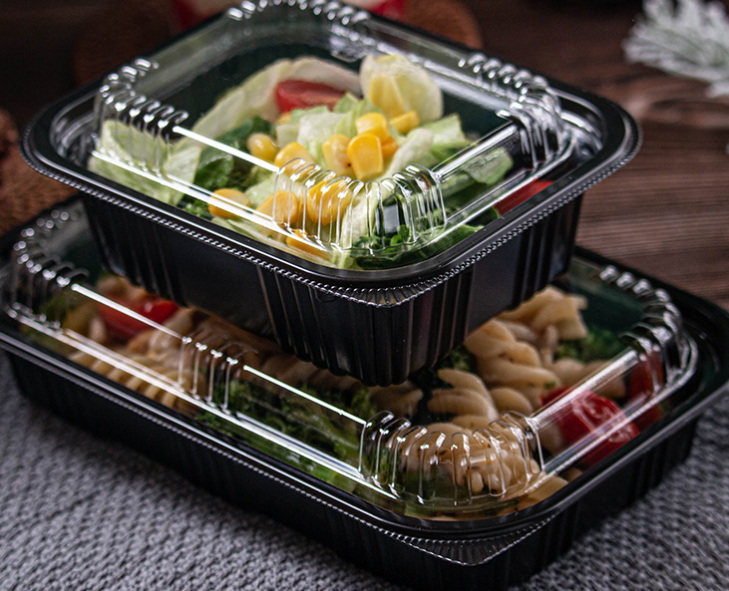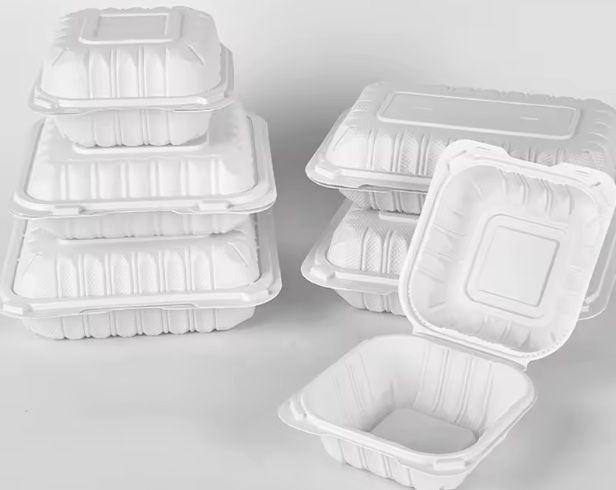
Content Menu
● Introduction to Plastic Lunch Boxes
>> Advantages of Plastic Lunch Boxes
>> Disadvantages of Plastic Lunch Boxes
● Key Factors to Consider
>> 1. Material Safety
>> 2. Durability and Functionality
>> 3. Environmental Considerations
>> 4. Size and Portability
>> 5. Cost-Effectiveness
● Tips for Using Plastic Lunch Boxes Safely
● Alternatives to Plastic Lunch Boxes
● Choosing Sustainable Options
● Industry Trends and Innovations
● Consumer Awareness and Responsibility
● Conclusion
● Frequently Asked Questions
>> 1. What Materials Are Used to Make Plastic Lunch Boxes?
>> 2. Are Plastic Lunch Boxes Safe for Reheating Food?
>> 3. How Can I Reduce the Environmental Impact of Using Plastic Lunch Boxes?
>> 4. What Are the Alternatives to Plastic Lunch Boxes?
>> 5. How Do I Ensure the Hygiene of Plastic Lunch Boxes?
● Citations:
In today's fast-paced world, the demand for convenient and portable food storage solutions has led to a surge in the use of plastic lunch box disposable options. These containers are widely used for packing lunches, snacks, and even takeout meals due to their ease of use and affordability. However, with the increasing awareness about environmental sustainability and food safety, choosing the right plastic lunch box disposable has become more critical than ever. This article will guide you through the key factors to consider when selecting high-quality plastic lunch box disposable options, ensuring they meet your needs while being safe for use.

Introduction to Plastic Lunch Boxes
Plastic lunch boxes are made from various types of plastic materials, such as polypropylene (PP) and polystyrene (PS). These materials are chosen for their durability, affordability, and ease of production. However, it's essential to understand the pros and cons of each material type to make an informed decision.
Advantages of Plastic Lunch Boxes
1. Convenience: Plastic lunch boxes are lightweight, easy to carry, and require no washing or cleaning after use, making them ideal for busy lifestyles[2].
2. Affordability: They are generally inexpensive and can be purchased in bulk, which is beneficial for both personal and commercial use[2].
3. Versatility: Available in various sizes and shapes, they can accommodate different types of food, from sandwiches to salads[2].
Disadvantages of Plastic Lunch Boxes
1. Environmental Impact: Plastic is not biodegradable and contributes significantly to waste management issues[3][5].
2. Durability: While durable, they can crack or break if handled roughly, leading to spills or leaks[5].
3. Hygiene: Single-use plastic containers can harbor bacteria if not disposed of properly[1].
Key Factors to Consider
When choosing a high-quality plastic lunch box disposable, several factors should be considered:
1. Material Safety
Ensure the plastic used is food-grade and safe for storing and reheating food. Polypropylene (PP) is a popular choice as it is non-toxic and can withstand microwave heating[1]. Always check for BPA-free certification to avoid potential health risks associated with certain plastics.
2. Durability and Functionality
Opt for containers with secure lids to prevent spills and leaks. Look for features like reinforced bottoms and tamper-evident seals to ensure food integrity[1]. The rigidity of the container is also important; a stiffer box will be less prone to damage during transport.
3. Environmental Considerations
Consider eco-friendly alternatives or recyclable plastic options to reduce environmental impact. Biodegradable materials are becoming increasingly popular as a sustainable choice[7]. Compostable or recyclable materials can significantly reduce waste accumulation in landfills and oceans.
4. Size and Portability
Choose a size that fits your needs, whether for a single meal or multiple snacks. Portability is crucial for on-the-go use. Compartmentalized lunch boxes are particularly useful for keeping different food items separate, which can be beneficial for maintaining flavor and texture[7].
5. Cost-Effectiveness
Balance quality with affordability. While cheaper options might seem appealing, they may not offer the same durability or safety as higher-quality alternatives. Consider purchasing in bulk to save money without compromising on quality.
Tips for Using Plastic Lunch Boxes Safely
1. Proper Disposal: Ensure that used containers are disposed of correctly to minimize environmental impact. Recycling or composting when possible can significantly reduce waste[3].
2. Avoid Overheating: Be cautious when reheating food in plastic containers to prevent chemical leaching. Always follow the manufacturer's guidelines for microwave use[1].
3. Cleanliness: Although disposable, ensure any reusable parts are cleaned properly to prevent bacterial growth.

Alternatives to Plastic Lunch Boxes
For those looking to reduce plastic use, alternatives include:
- Reusable Containers: Made from materials like stainless steel or silicone, these are durable and eco-friendly.
- Compostable Containers: Made from plant-based materials, these are biodegradable and environmentally friendly.
Choosing Sustainable Options
In recent years, there has been a shift towards more sustainable disposable food containers. These include biodegradable plastics, compostable fibers, and recyclable materials. When selecting a plastic lunch box disposable, consider options that are designed with environmental sustainability in mind. This not only helps reduce waste but also supports a healthier ecosystem.
Industry Trends and Innovations
The industry is moving towards more eco-friendly packaging solutions. Innovations include the use of plant-based bioplastics and compostable materials that can replace traditional plastics. These alternatives offer the same convenience as traditional plastic lunch boxes but with a significantly reduced environmental footprint.
Consumer Awareness and Responsibility
As consumers, it's crucial to be aware of the environmental impact of our choices. By choosing sustainable options and ensuring proper disposal, we can contribute to reducing plastic waste. Additionally, supporting companies that prioritize eco-friendly packaging can drive industry change towards more sustainable practices.
Conclusion
Choosing the right plastic lunch box disposable involves balancing convenience, safety, and environmental considerations. By understanding the materials, features, and alternatives available, you can make informed decisions that suit your lifestyle while contributing to a more sustainable future.

Frequently Asked Questions
1. What Materials Are Used to Make Plastic Lunch Boxes?
Plastic lunch boxes are typically made from materials like polypropylene (PP), polystyrene (PS), and sometimes biodegradable materials. PP is preferred for its durability and microwave safety[1].
2. Are Plastic Lunch Boxes Safe for Reheating Food?
Yes, many plastic lunch boxes, especially those made from polypropylene (PP), are safe for reheating food in the microwave. However, it's crucial to follow the manufacturer's guidelines to avoid overheating[1].
3. How Can I Reduce the Environmental Impact of Using Plastic Lunch Boxes?
To reduce environmental impact, consider using recyclable or biodegradable containers. Proper disposal and recycling of plastic containers can also help minimize waste[3][5].
4. What Are the Alternatives to Plastic Lunch Boxes?
Alternatives include reusable containers made from materials like stainless steel or silicone, and compostable containers made from plant-based materials.
5. How Do I Ensure the Hygiene of Plastic Lunch Boxes?
Ensure that any reusable parts are cleaned properly, and always dispose of single-use containers after use to prevent bacterial growth[1].
Citations:
[1] https://www.nbyuxiang.net/news/industry-news/the-key-features-of-disposable-plastic-lunch-boxes.html
[2] https://www.nbyuxiang.net/news/industry-news/advantages-and-disadvantages-of-disposable-plastic-lunch-boxes.html
[3] https://www.nbyuxiang.net/news/industry-news/the-environmental-impact-of-disposable-lunch-box.html
[4] https://www.nblinhua.com/news/industry-news/how-to-buy-a-disposable-lunch-box-2.html
[5] https://www.eco-harvest.com/blogs-detail/--38
[6] https://www.industrykitchens.com.au/Blog/disposable-food-containers/
[7] https://www.easyngreen.com/advantages-of-using-compartment-disposable-lunch-boxes.html
[8] https://www.packagingbag5.com/news/the-environmental-impact-of-disposable-lunch-b-78122456.html
[9] https://unisupply-industrial.en.made-in-china.com/product/mxYrRMlbOKUC/China-Sustainable-High-Transparency-Square-Disposable-Plastic-Lunch-Box.html
[10] https://www.quitplastic.in/post/the-hidden-dangers-of-single-use-paper-food-containers
[11] https://damatiplastics.com/choosing-the-right-size-and-shape-of-hinged-plastic-disposable-food-containers-for-your-business/
[12] https://www.alibaba.com/showroom/high-quality-plastic-lunch-box.html
[13] https://www.dashanpacking.com/advantages-of-plastic-disposable-food-containers/
[14] https://www.epd.gov.hk/epd/sites/default/files/epd/english/environmentinhk/waste/pub_consult/files/tableware-con-doc-en.pdf
[15] https://www.easyngreen.com/how-to-choose-the-best-disposable-food-containers.html
[16] https://www.versupack.com/ee/uudised/item-27/
[17] https://polymeruk.com/blogs/news/8-benefits-of-disposable-food-packaging
[18] https://myneemoe.in/blogs/news/what-is-the-impact-of-reusable-lunch-containers-on-reducing-environmental-waste
[19] https://www.yummytoddlerfood.com/best-disposable-lunch-box-and-container-options/
[20] https://unisupply-industrial.en.made-in-china.com/product/mxYUkRPhuKpc/China-Leakproof-Multiple-Sizes-Square-PP-Disposable-Lunch-Boxes.html

















